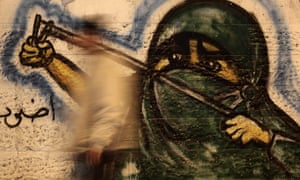
Six months after it began, a deadly wave of violence between Palestinians and Israelis that has been referred to as the “knife intifada” shows no sign of ending, despite a drop in incidents from a high point last autumn.
The figures make for grim reading: since October, 211 stabbings of Israelis by Palestinians have been reported, in addition to 83 shootings and 42 car-ramming attacks, responsible in total for the deaths of 30 Israelis and two American citizens. More than 200 Palestinians have been killed, of whom more than 130 died while allegedly carrying out attacks on Israelis.
The cycle began in early October with two incidents that followed weeks of growing tensions, initially fuelled by arguments over the religious site in Jerusalem known to Muslims as the Noble Sanctuary and site of the al-Aqsa mosque, and to Jews as the Temple Mount. On 1 October, an Israeli couple were killed in the northern West Bank by a Hamascell. Two days later, two Israeli men were stabbed to death in the Muslim quarter of Jerusalem’s Old City. A spate of similar attacks ensued, many involving knives and scissors.
As the violence has dragged on, an already toxic mood of mistrust and recrimination has deepened between the two sides – a situation bleakly characterised in a confidential EU heads of mission report on Jerusalem, prepared annually by senior European diplomats and seen by the Guardian.
“Violence escalated particularly over the autumn and polarisation reached levels unprecedented since 1967,” its authors write, referring to the aftermath of the six-day war when east Jerusalem and the West Bank was occupied by Israel. “Prospects for peace receded further. Overall a new reality was increasingly evident in Jerusalem, one marked by growing Palestinian alienation and marginalisation, a loss of hope in the possibility of positive change, deep mutual mistrust and a sense of loss of security among both communities.”
Unlike the first and second intifadas, the current wave of violence has remained in essence leaderless, characterised largely by so-called “lone wolf” attacks, often low tech and with those involved both young and often detached from the armed factions.
If a change has taken place in recent months it is that the patterns of violence – and support for it – have been subtly transformed.
Largely focused on Jerusalem to begin with, most violent incidents are now clustered around a small number of West Bank hotspots, including the city of Hebron, the Gush Etzion and Tapuach junctions, and in the area of Ramallah and the Israeli settlement city of Ariel.
Striking too has been the drop in Palestinian support for knife attacks on Israelis – increasingly viewed as lacking in “efficacy” – despite the fact that a majority still support attacks on Israelis and widening the conflict into a full-scale intifada with broad political support.
That issue was flagged up by the most recent survey by the Palestinian Centre for Policy and Survey Research, which showed a drop in support for knife attacks from 67 percent last December to 58 percent in March.
“There is a notable drop in the West Bank in the support for knifing attacks, due, it seems, to a rising perception in its inefficacy ... [in] help[ing] achieve national rights in ways that negotiations could not,” the research centre reported, while noting a majority still supported a wider armed intifada.
That change, perhaps, explains other recent transformations in the nature of the knife intifada, not least the increased visibility of firearms in attacks – often cheap, locally manufactured weapons known as “Carlos” – and the increased phenomena of attacks involving more than one assailant.
Another recent shift noted by Israeli security officials has been in what they view as the main engine for violence. That has seen individuals decide – sometimes in a time frame as short as a few hours – to embark on an attack, inspired by deaths of friends, family or someone in their village. “Often it is about wanting to react. If you check more deeply you find more personal reasons. A quarrel in the family. Problems between a husband and wife ... economic problems.”
Another factor that has changed in recent months – according to both Israeli and Palestinian officials – is the increasingly active role of the Palestinian security forces, who were largely absent from the clashes with Israeli troops and police in the early months but have been reasserting their presence.
If the volume of acts has dropped since the beginning of the year, the current trend is flat, describing a continuing, slow drizzle of violence marked by more serious incidents with a potential for new flare-ups.
The continuing violence has exposed other faultlines: between Israel’s more pragmatic military and Netanyahu’s rightwing coalition, within an Israeli publicdisappointed with the government’s handling of the situation, and between a weakened and increasingly isolated Abbas and Palestinian popular opinion.
Despite the recent drop in the number of incidents, officials on both sides are concerned that attacks might pick up again during the period of Israeli religious holidays in April.
No comments:
Post a Comment